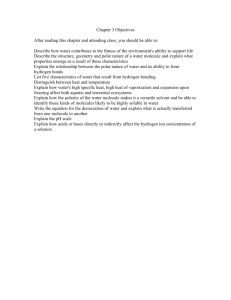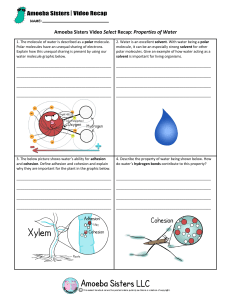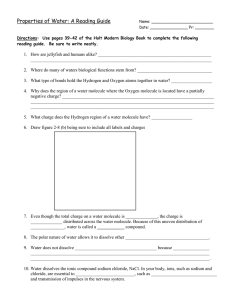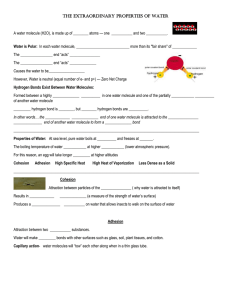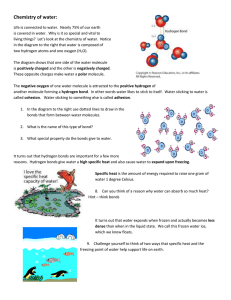notes
advertisement
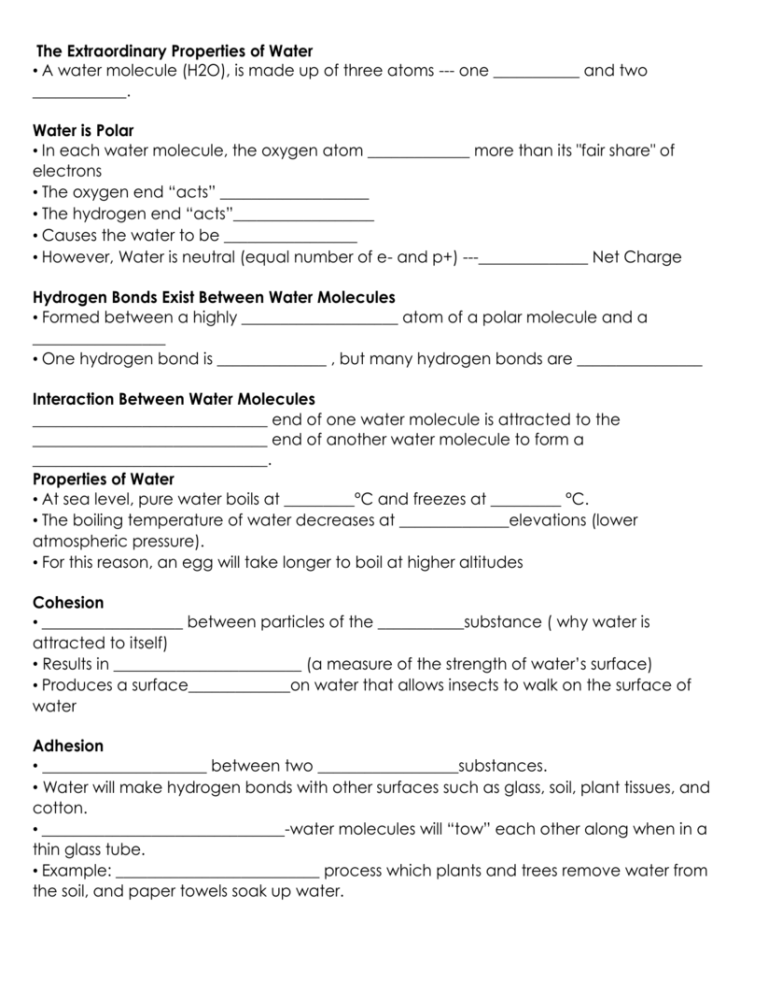
The Extraordinary Properties of Water • A water molecule (H2O), is made up of three atoms --- one ___________ and two ____________. Water is Polar • In each water molecule, the oxygen atom _____________ more than its "fair share" of electrons • The oxygen end “acts” ___________________ • The hydrogen end “acts”__________________ • Causes the water to be _________________ • However, Water is neutral (equal number of e- and p+) ---______________ Net Charge Hydrogen Bonds Exist Between Water Molecules • Formed between a highly ____________________ atom of a polar molecule and a _________________ • One hydrogen bond is ______________ , but many hydrogen bonds are ________________ Interaction Between Water Molecules ______________________________ end of one water molecule is attracted to the ______________________________ end of another water molecule to form a ______________________________. Properties of Water • At sea level, pure water boils at _________°C and freezes at _________ °C. • The boiling temperature of water decreases at ______________elevations (lower atmospheric pressure). • For this reason, an egg will take longer to boil at higher altitudes Cohesion • __________________ between particles of the ___________substance ( why water is attracted to itself) • Results in ________________________ (a measure of the strength of water’s surface) • Produces a surface_____________on water that allows insects to walk on the surface of water Adhesion • _____________________ between two __________________substances. • Water will make hydrogen bonds with other surfaces such as glass, soil, plant tissues, and cotton. • _______________________________-water molecules will “tow” each other along when in a thin glass tube. • Example: __________________________ process which plants and trees remove water from the soil, and paper towels soak up water. High Specific Heat • Amount of ____________ needed to raise or lower _______g of a substance ______° C. • Water _____________________________________________, both for heating and cooling. • Water can absorb or release large amounts of heat energy with little change in actual temperature. High Heat of Vaporization • Amount of energy to convert 1g or a substance from a _________________________________ • In order for water to evaporate, ______________________ __________________________________. • As water ____________________________, it removes a lot of heat with it. • Water vapor forms a kind of global ‘‘blanket” which helps to keep the ________________________. • Heat radiated from the sun warmed surface of the earth is absorbed and held by the vapor. Water is Less Dense as a Solid • _____________________________ as a solid than as a liquid (ice floats) • Liquid water has hydrogen bonds that are constantly being broken and reformed. • _________________________ forms a __________________________________ whereby molecules are set at fixed distances. Universal Solvent • Water is usually part of a ____________________. • Water keeps the pieces suspended so they don’t settle out. • SOLUTE • Substance that is being ____________________ • SOLVENT • Substance into which the __________________ Homeostasis • Ability to maintain a _______________________________ despite changing conditions • Water is important to this process because: a. Makes a _____________________ b. Resists temperature change c. _________________________ d. Coolant e. Ice protects against temperature extremes (_____________________ frozen lakes)


